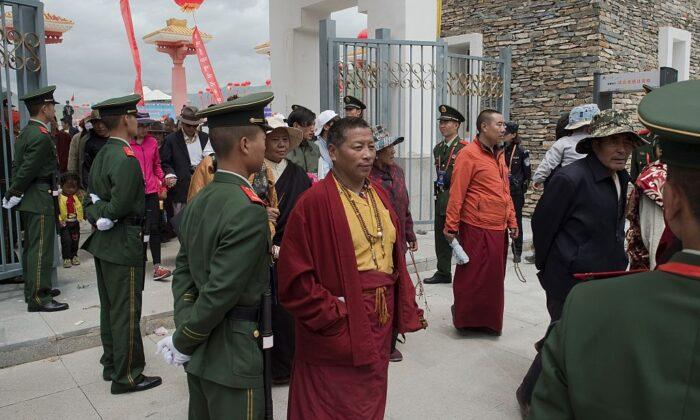A
new study from the University of Toronto reveals a massive police-led iris scan collection campaign conducted in China’s western province of Qinghai, which researchers said could be used for increased state control and repression of ethnic and religious minorities and critics of the communist regime.
The study, published by U of T’s The Citizen Lab on Dec. 14, looked at nearly 190 publicly available sources, including the official social media accounts of the Chinese regime or public security bureau and local news reports. Among these sources, 53 contained figures showing that between March 2019 and July 2022, Chinese police may have collected between roughly 1,250,000 and 1,450,000 iris scans, representing between one-fifth (21.1 percent) and a quarter (25.6 percent) of Qinghai’s total population of 5.9 million.
“The number of irises scanned would make mass iris scan collection in Qinghai the largest known program conducted in China relative to population,” said the study, noting that the possible exception is an earlier program in the Xinjiang region.
The study said the police have given “vague justifications” for iris scan collection, which include fighting crime, finding missing people, and upgrading national ID cards. But the lack of a single justification for the biometric data collection indicates that the iris scan could be used for other, more concerning purposes, the study said.
“Police could use iris recognition tools to identify missing people. Or police could use these same tools as part of broader programs of surveillance and ’
ethnic sorting’ directed against ethnic minority communities,” it said.
“Police could also use the collection of iris scans or other biometric data as a way to deepen control over critics of the Chinese state,” it added, saying that the “deepening of control” is already underway, citing a number of Western media reports.
Following the nationwide protests against the Chinese Communist Party’s (CCP) draconian pandemic control policies in late 2022, the Chinese police have reportedly collected the “
retina patterns“ of demonstrators held in custody, while also using surveillance cameras with
facial recognition capabilities to identify protesters and warn them against participating in future demonstrations.
Timeline of China’s Iris Scan Collection
China’s iris scan collection campaign dates back to the mid-2010s, with the earliest programs focusing on the issue of missing children, according to Citizen Lab.
In 2016, iris recognition technology company EyeSmart proposed the building of 100 stations across Wuhan in Hubei Province to collect iris scans from children, reported CCP-owned media
China Daily. In the following year, the Chinese authorities launched a national children’s iris database containing 40,000 iris scans, said
a report on the online version of People’s Daily, the official newspaper of the CCP’s Central Committee.
In 2016, the Beijing Public Security Bureau began building an iris scan database focused on “target people,” according to
a conference paper published by the Germany-based Springer and cited by Citizen Lab. Target people is a term used to describe Chinese citizens who the police consider a threat to social stability, which include drug users, practitioners of banned faiths, petitioners, and people with mental health issues, according to Citizen Lab.
One of the earliest known police-led mass iris scan collection programs dates back to at least 2017 in the Xinjiang region,
reported Human Rights Watch. The program, targeting all residents in the region between the age of 12 and 65, also collected other biometrics, including DNA samples, fingerprints, iris scans, and blood types.
China’s Ministry of Public Security, which is in charge of the country’s public and political security, began exploring a national program of iris scan collection in 2019, releasing the “Notice on Implementing Iris Information Collection and Application Work” in April that year.
The Citizen Lab’s study noted that
academic writing and
industry publications in China have suggested that the Notice is a call for Public Security Bureaus across China to support the application of the Ministry of Public Security’s “iris system” and for provincial-level Criminal Investigation Branches to begin building “province-level iris systems.”
Another
national-level document, titled “Construction Plan for National Criminal Investigation Information Specialized Application System’s Iris Identity Inspection Subsystem,” released by the Ministry of Public Security in
February 2019, also called for strengthening iris scan database construction, the study said. The plan said the purpose of biometrics data collection was to combat crime and for “social management and control.”
There are also indications that municipal public security bureaus in China have invested in building iris databases large enough to cover entire local populations. In 2019, the Beijing Municipal Public Security Bureau and technology company IrisKing announced the building of a database capable of containing up to
20 million iris scans, roughly equivalent to the city’s population of
21.89 million.
In light of these concerns, Citizen Lab called for establishing international norms surrounding the practice of iris scan collections.
“Presently, there is a lack of international norms concerning police collection, storage, and use of biometric data like iris scans. At the global level, states, civil society groups, researchers, and international organizations should work together to establish relevant norms and support mechanisms that monitor adherence to these norms and identify possible violations,” the researchers said.
“At the national level, states—including China—must enact and enforce strict limits on police collection, analysis, and storage of iris scans and other sensitive biometric data, in order to minimize the potential harm to those from whom data were collected, their kin, and their wider community.”





